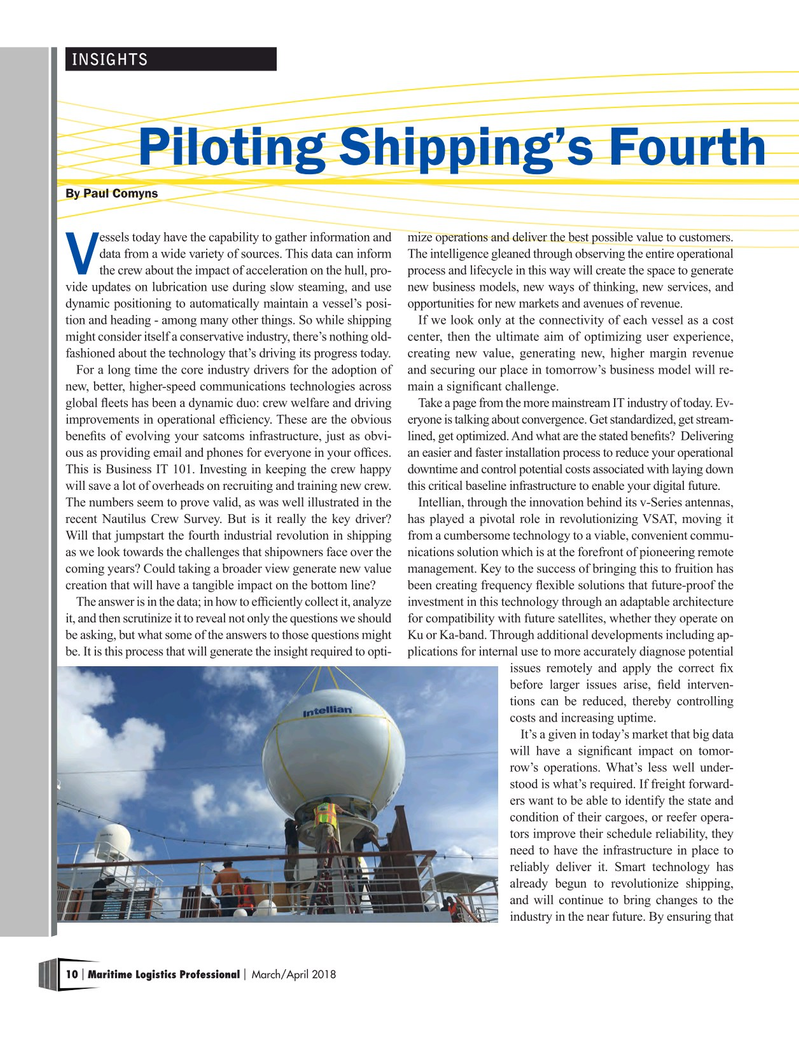
Page 10: of Maritime Logistics Professional Magazine (Mar/Apr 2018)
IT & Software
Read this page in Pdf, Flash or Html5 edition of Mar/Apr 2018 Maritime Logistics Professional Magazine
INSIGHTS
Piloting Shipping’s Fourth
By Paul Comyns essels today have the capability to gather information and mize operations and deliver the best possible value to customers. data from a wide variety of sources. This data can inform The intelligence gleaned through observing the entire operational
Vthe crew about the impact of acceleration on the hull, pro- process and lifecycle in this way will create the space to generate vide updates on lubrication use during slow steaming, and use new business models, new ways of thinking, new services, and dynamic positioning to automatically maintain a vessel’s posi- opportunities for new markets and avenues of revenue. tion and heading - among many other things. So while shipping If we look only at the connectivity of each vessel as a cost might consider itself a conservative industry, there’s nothing old- center, then the ultimate aim of optimizing user experience, fashioned about the technology that’s driving its progress today. creating new value, generating new, higher margin revenue
For a long time the core industry drivers for the adoption of and securing our place in tomorrow’s business model will re- new, better, higher-speed communications technologies across main a signifcant challenge. global feets has been a dynamic duo: crew welfare and driving Take a page from the more mainstream IT industry of today. Ev- improvements in operational effciency. These are the obvious eryone is talking about convergence. Get standardized, get stream- benefts of evolving your satcoms infrastructure, just as obvi- lined, get optimized. And what are the stated benefts? Delivering ous as providing email and phones for everyone in your offces. an easier and faster installation process to reduce your operational
This is Business IT 101. Investing in keeping the crew happy downtime and control potential costs associated with laying down will save a lot of overheads on recruiting and training new crew. this critical baseline infrastructure to enable your digital future.
The numbers seem to prove valid, as was well illustrated in the Intellian, through the innovation behind its v-Series antennas, recent Nautilus Crew Survey. But is it really the key driver? has played a pivotal role in revolutionizing VSAT, moving it
Will that jumpstart the fourth industrial revolution in shipping from a cumbersome technology to a viable, convenient commu- as we look towards the challenges that shipowners face over the nications solution which is at the forefront of pioneering remote coming years? Could taking a broader view generate new value management. Key to the success of bringing this to fruition has creation that will have a tangible impact on the bottom line? been creating frequency fexible solutions that future-proof the
The answer is in the data; in how to effciently collect it, analyze investment in this technology through an adaptable architecture it, and then scrutinize it to reveal not only the questions we should for compatibility with future satellites, whether they operate on be asking, but what some of the answers to those questions might Ku or Ka-band. Through additional developments including ap- be. It is this process that will generate the insight required to opti- plications for internal use to more accurately diagnose potential issues remotely and apply the correct fx before larger issues arise, feld interven- tions can be reduced, thereby controlling costs and increasing uptime.
It’s a given in today’s market that big data will have a signifcant impact on tomor- row’s operations. What’s less well under- stood is what’s required. If freight forward- ers want to be able to identify the state and condition of their cargoes, or reefer opera- tors improve their schedule reliability, they need to have the infrastructure in place to reliably deliver it. Smart technology has already begun to revolutionize shipping, and will continue to bring changes to the industry in the near future. By ensuring that 10 Maritime Logistics Professional March/April 2018 | |

 9
9

 11
11
